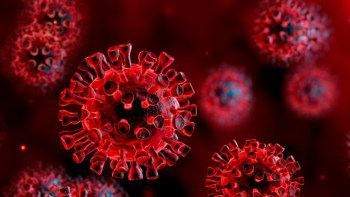Many key advances in the biological sciences have been made possible by physics-based techniques. The future of biomedicine depends on collaboration between the two fields
Biomedical science has undergone a revolution in the past few years. A decade ago biologists studied proteins and genes one at a time. Today they are able to monitor almost 10 000 genes in a single experiment using so-called “labs on a chip”. These devices are made from silicon wafers that have been machined using lithography techniques borrowed from the semiconductor industry. As a result biological data are flooding in at an incredible rate, and biologists are beginning to realize that they have much to learn from physicists and astronomers who have been dealing with large amounts of experimental data for decades.
Present-day biology relies enormously on tools that have been largely developed by physicists. Synchrotron radiation sources are in continual demand for protein-crystallography experiments, while techniques such as electron microscopy, nuclear magnetic resonance and optical tweezers have led to key advances in structural biology.
New challenges for physicists
In his article, Harold Varmus, director of the National Institutes of Health in the US, asserts that physicists do much more than simply develop instruments for biologists. He surveys the past contributions of physicists to biology and outlines three areas where he believes physicists can make a real impact in scientific terms. First, they can develop methods to examine the physical and chemical properties of single macromolecules and single complexes of large molecules. Second, they can interpret complex data sets to understand why cells develop in different ways (i.e. to understand the process of “gene expression”). And third, they can understand the “signalling pathways” that link changes in gene expression within the cell nucleus to molecular interactions at the cell surface. Varmus also addresses some of the problems involved in enabling researchers from different scientific disciplines and cultures to work together on biological problems.
The behaviour of living biological systems, such as cells, cannot be explained by the sum of their components. And the challenge of tackling this complexity in biology is attracting increasing numbers of physicists. Manfred Radmacher for example, describes in his article how experiments with atomic-force microscopes are shedding light on a whole host of biological processes. These versatile instruments can be used to measure the elasticity of single molecules, determine the strength of individual chemical bonds, and monitor how the shape of a single molecule changes as it functions.
The shape of a protein molecule is just as important as its chemical composition, and one of the greatest challenges in biology is to understand how a long, one-dimensional molecule “folds” into a working three-dimensional structure. In their article (see summary), Peter Wolynes and William Eaton explain how in the last decade physical scientists have made real progress in understanding how proteins fold. The theory of protein folding has many parallels with the theory of so-called “spin glasses” in magnetic alloys. If we can understand the physical process of protein folding then we may be able to develop computer algorithms that can predict the structure of a protein from its chemical components. This would allow biomedical scientists to create drugs and therapies much faster than is currently possible.
An equally challenging problem is to understand the ways in which information is stored and processed by the brain. This information is transmitted as electrical pulses, and many of the basic processes are understood at the level of single nerve cells or “neurons”. Physics-based techniques, such as positron-emission tomography and functional magnetic-resonance imaging, are also revealing much about how the different areas of the brain work. However, we cannot simply describe the brain as a vast collection of nerve cells. In their article (see summary), Chris Wilkinson and Adam Curtis describe attempts to grow simple networks of living nerve cells on artificial substrates to better understand the nervous system. This work, which is still at an early stage, requires the combined efforts of many types of biologist as well as biophysicists and electronic engineers. Indeed, funding agencies and academic institutions throughout the world are recognizing the need for interdisciplinary research by promoting new fellowship schemes and building dedicated research centres (see Physics World February 1999).
The importance of physics
Many of today’s high-profile biological advances have their roots in physics-related technologies that were developed decades ago. Now biology is rapidly becoming a science that demands a more intense mathematical approach, and a new way of thinking, if we are to have a more physical explanation of biological behaviour. With physicists who can manipulate single molecules and solve complex problems in a quantitative way, the revolution in the biomedical sciences looks set to continue for some time to come.



